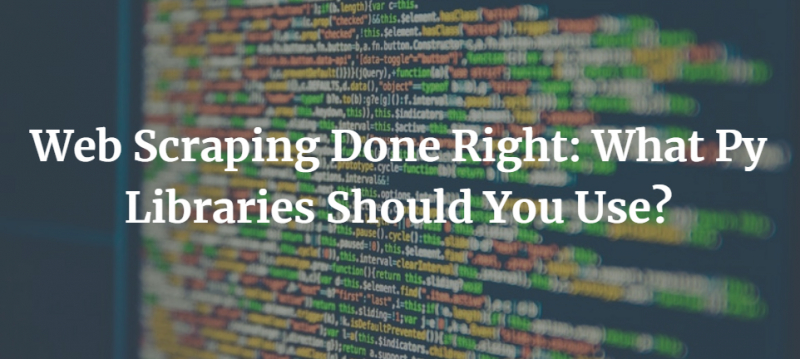Web scraping is not a new technique, but it has become more popular in today’s era of big data. Web scraping is incredibly useful for capturing a vast amount of data over a short period of time; it takes the manual work out of collecting information from various online sources.

As automated data collection becomes more popular, it is adopted in a wider variety of situations. You can, for instance, use scraping to gather marketing data, collect emails or contact details. A lot of online travel agents use web scraping to collect airline ticket prices or information about hotel rates automatically. Others use web scraping for collecting data about competitors.
There are also multitudes of tools available for web scraping. And, while Python has become the probably most used programming language for web scraping in the world, there are a lot of debate about the best Py libraries to use, as scraping professionals constantly debate over using Selenium or whether you can compare Scrapy vs BeautifulSoup.
Why Python?
A lot of web scraping tools are made using Python for a number of simple reasons, starting with the fact that Python is a programming language with a large community of developers behind it. Since there are more developers supporting the programming language, there are more ready-made libraries, frameworks, and programming tools available for Python.
Python is also relatively easy to use compared to other programming languages. As a coding language, Python is also known to be flexible. You can integrate different libraries and existing frameworks, eliminating the need to code something from scratch when you want to develop new apps using Python.
Even better, Python is easy to integrate. A lot of web scraping tools made using Python work really well with additional tools and modules for data processing. For example, you can streamline data collection and processing using multiple tools in a pipeline. As long as the input parameters are correct, the whole process is fully automated.
Add the fact that Python codes are optimized, and you get the perfect framework for developing apps like web scraping tools. You don’t need long codes and complex programs to get the results you are searching for.
Web Scraping Using Python
The process of web scraping happens in four simple steps. First, a URL is crawled, and the page is analyzed. Next, the scraping tool will find the exact data you want to extract based on predetermined parameters. The next part of the process is making sure that the same pattern is found when other pages are crawled so that the process can be repeated.
Once relevant details are extracted, the information gets processed and displayed. You can choose to use the information directly or do more processing to refine the insights further. As mentioned before, the entire process can be streamlined using multiple Python libraries.
Speaking of Python libraries, there are a quite a few to choose from. Scrapy is perhaps the most popular library for web crawling since it was developed from the ground up as a web spider. The latest version can also handle scraping information from APIs; it can make direct API calls and store information accordingly.
Beautiful Soup can be used to parse HTML and XML pages. When combined with a web scraping tool like Scrapy, Beautiful Soup can make information on web pages and other sources easier to extract. It may not have built-in crawlers, but the library is easy to integrate with other tools made using Python.
For data analysis, you can use Pandas. This Python library is very popular for analyzing data. It structures the crawled data to make further analysis easier. It also manipulates data based on the parameters you define, which means you can use Pandas to gain relevant insights from a massive data stream.
To ensure smooth and effective crawling, it is also a good idea to add a web scraping proxy. A web scraping proxy acts as an intermediary between your computer – the computer running scraping scripts – and the servers you want to crawl. The proxied IP addresses are less prone to security measures like blocking and banning.
Scraping with Beautiful Soup and Scrapy
As explained before, the best way to get relevant and contextual information through web scraping is by utilizing multiple Python tools. In this case, you can combine Beautiful Soup and Scrapy to effectively collect data from various online sources.
Scrapy will handle the crawling part of the equation. The tool is designed to create crawlers that will scour the internet for relevant pages. It will then download and store information, mainly in HTML form, for processing. It is a capable crawling tool, but it has limited ability to parse information on a more advanced level.
Start with the scope of your project. Scrapy lets you define the scope using parameters such as allowed_domains and start_urls, so it is easy to limit the scope of the project to certain websites or a cluster of them.
This is where Beautiful Soup comes in handy. The HTML parsing tool is equipped with features and functions to extract specific information from web pages. It can also process XML documents, even when the structure of the documents is not properly organized. Beautiful Soup’s ability to be precise and accurate is what makes the combination so effective.
Additional modules like urllib2 can also be used to streamline the process further. Using native commands like info(), you can also collect additional information from the pages you crawl. This leads to a more refined scraping process since you can process data based on meta-information rather than the entire content.
Configure everything correctly and you will soon get relevant, contextual information from any source on the internet. Turning scraped data into insights will be an even more streamlined process once you start adding extra Python libraries to your workflow. The rest should be easy from there.





